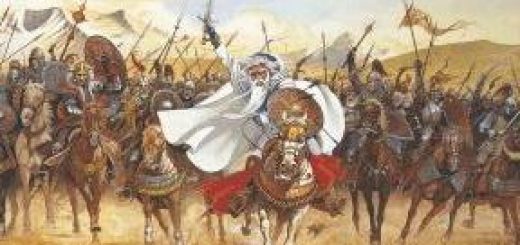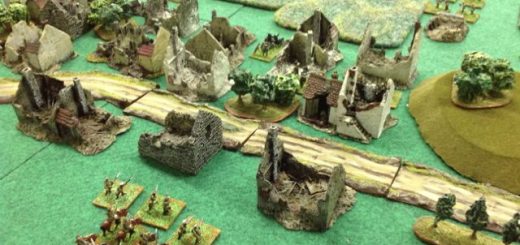Triumph and Tragedy
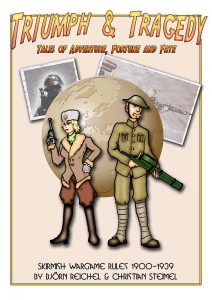
Early 1900 rules with colonial supplement rules from Germany, Forum is here.
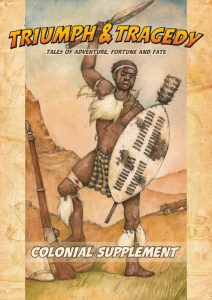
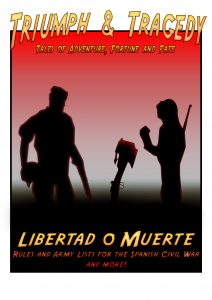
Reference Sheets.
Ancient rules adaption
Changes from the original âTriumph and Tragedyâ, by Lt. Hazel and friends.
Suppression and morale
A unit which has half as much or more suppressed markers as models remaining is considered âShakenâ. A unit which has as much or more suppression markers as remaining models is considered âbrokenâ. A shaken unit receives -1 on all its rolls, a broken unit -2. To represent the stress inflicted upon a broken unit, it has to pass a morale check before it can remove any suppression markers with a âRegroupâ order. If it fails the check, the unit routs. Remove it from the game.
When a unit fails its morale check, it is not removed entirely unless the unit is already âBrokenâ. If a unit fails its check and isnât broken, it simply falls back W3 inches. In Close Combat, the enemy unit may then opt if it wants to stand its ground or if it wants to follow up. If it does follow up, immediately start another round of close combat with the following-up unit as attacker. If a broken unit fails its morale check it is removed as usual.
Damage tables
âWoundedâ results also generate suppression markers.
Orders
Passive Orders always trigger when their conditions are met.
Active Orders have to be executed with a âmove and Leader actionâ order to take effect
Leaders and wound distribution
As leaders always fought in the first row, at least ¼ of hits have to be assigned to the Squad leader or hero, if present.
Special Rules:
Romans: Shield Wall(Active Order)
Enemies attacking this unit in the front arc get -1 on their roll to hit. This unit cannot make fast moves and loses one die when determining its attack move.
Ride ’em down(passive order)
When this unit makes a fast move, it may move over any enemy units if it is able to completely clear it. 50% of this unit may execute a Close Combat attack, but it loses one rider for every 1 rolled.
Change position!(active order)
Every friendly unit in 6 inches that passes a morale test may move up to D6 inches. Roll for each unit separately. Use only once per battle. As this ability is very powerful, it should only be useable by the armies leader.
Germans:
Javelin Charge(passive order)
When using a âChargeâ order to get into Close Combat, half of the models in this unit may perform a shooting attack hitting on 8+. Use only once per battle.
Berserker Rage(active order)
This unit receives +2 on rolls to hit in Close combat, but suffers a -1 modifier on the wound chart.
Follow me(passive order)
When this unit moves into Close Combat, nominate a friendly unit in 8 inches. If it passes a morale check, it may also attempt to move into Close Combat with the enemy attacked by this unit. Use only once per battle. As this ability is very powerful, it should only be useable by the armies leader.
In our game, we also gave each Squad leader and Hero special abilities based on their backstory. If you’re interested in those as well, I will post them later.
Titus(Roman Hero)
Titus has lived a rich and full life as a soldier, and now simply wants to retire in peace. But the sudden germanic onslaught forces him to load all his possessions and collected taxes into a single waggon and make a break for the more civilized parts of the empire.
Death before poverty!
When Titus is in a 6 inch radius to the gold cart, he automatically passes all morale checks.
Nasus
Son of a roman merchant, Nasus has enjoyed a higher education and is a semi-talented poet, but of course, this isn’t good enough for his father! He sees his son as a politician, a senator-maybe even a consul! And of course, having served in the legion is almost a requirement for any successful statesman. Nasus is an abyssmal soldier, but his father’s money paves the way and so, the mild-mannered artistic boy stands in wild Germania, leading a unit of soldiers and desperately seeks for a way out.
Daddy’s boy
Whenever Nasus tries to use an order or orders an attack, roll a die. On a â1â, the soldiers âmishearâ the command and instead fall back D6 inches.
Claudius Quintus
Descendant from an old noble house, Claudius is the embodiement of roman pride. But, as a 5th child, he will inherit nothing from his familys wealth. Because of this, he seeks to prove himself in military prowess and has acquired a notorius reputation of carrying out brutal punitive strikes against the local population.
Roman Devil
When a german unit is in close combat with Claudius Quintus, roll a D6:on a 1-4, they get -1 to hit as they are scared by his terrible reputation. On a 5 and 6, they take the chance to finish the hated oppressor once and for all. They add +1 to all their combat rolls.
Reliantus
A former slave from the mines, he has a life debt to Titus.
A life for a life!
When Titus suffers a mortal wound in 6 inches to Reliantus, you may remove Reliantus to cancel the wound.
Polonius
Polonius is a brigand and poacher who got to choose between serving in the legion or facing a long-term prison sentence. His natural cunning make him a good scout. He just wants to somehow get through with the whole âmilitaryâ stuff and finally be back under the tuscanys warm sun and do the job he has always done.
Take to the hedges!
When polonius and his squad start the turn suppressed, you may roll a die: on a 5 or 6 you may remove the squad from the game and place them at the start of the next turn in any forest terrain without any pinned markers. On a 2-4, nothing happens and on a 1 the entire unit deserts. This guy is a criminal, after all.
Germans
Haethelmar(German Hero)
Chief Haethelmar despises the romans who dare to treat him like a servant in his own country. For years, he has patiently waited for any signs of weakness and now, as tribun Titus is making his getaway, he sees the chance to strike!
Initiative
Roll a D6 when you activate Haethelmar. On a 6, he and his unit may perform a free movement action.
Atzul
Atzul is a true mercenary, greedy and ruthless. Even so he is loyal to Haethelmar, it wouldn’t hurt the chief much if some of the roman’s gold would go missing, would it?
Special Rule:
Greed
Whenever Atzul and his squad perform a move or fast move action, roll a D6. On a 1, they must move directly towards the gold cart.
Wulfgar
A former farmer, Wulfgar lost his entire family to a punitive strike of some roman marauders. And he will never forget the face of the leaer of these men…
Venegance and dread!
When Wulfgar is activated in a 9 inch distance to Claudius Quintus, he has to try to attack him. Do not roll for âRoman Devilâ. Trat Wulfgar and his unit as if they have rolled a 6!
Ragnar
So he wouldn’t admit it, Ragnar likes the romans. They brought wine, roads and profit with them and as a merchant Ragnar benefits from all of the above. But Haethelmar is hell-bent on his strike against them and, to ensure Ragnar’s cooperation, he has abducted his son! So Ragnar will have to help him, that is, for the tmoment at least!
Unreliable
When Haethelmar dies or flees the battlefield, immediately remove Ragnar and D3 members of his squad from the game.
Boat rules
Activation
The ship and its operating crew will get its own unit card. The crew will be divided in sub-crews (watches, if you like) which will all have their own unit cards. The player will have the option of activating watches and vessels in which ever way the think is strategically suitable. I think this will work best since the ships will not only be competing to get to the end of the board first but also need to fight each other and get away from various obstacles on their way. Not all orders are available to the ship or work slightly different. Orders such as ‘Cavalry Action’ is obviously not relevant and ‘Move and Shoot’ involves no penalty.
Movement
All player begins the turn by plotting in pencil the route of he ship he or she controls on a provided sea chart before anyone moves.
As suggested, the ships will be navigating within speed intervals, and that’s where the engine telegraph comes in. Each player will be given one flat cardboard telegraph per vessel which can be set for each activation. The indicated speed will remain till next activation because you can only change speed from one interval to the next one up or down. (Maybe it should be possible to to go between any speed interval in any direction but at the risk of damaging the ship. More about that below.).
So for example:
Ahead
Full 30cm + 2d6cm, 12″ +2D6″ (stefano’s mod in inches)
Half 20cm + 1d6cm, 8″ + 1D6″
Slow 10cm + 1d6cm 4″ + 1D6″
Standby Still in the water
Stop 5 cm astern (to account for river current) (2″ along current)
Astern
Finished with Engines Still in water
Slow 10cm + 1d6cm, 4″ + 1D6″
Half 15cm+ 2d6cm, 6″ + 1D6″
Full 20cm + 2d6cm, 8″ + 1D6″
Speeds will vary between types of crafts. The RN motor launches will obviously be faster than the steamer for example.
Combat
The fighting crews can move about the deck and shoot fight as per the regular rules. Fixed weapons, like deck guns, harpoon guns or rail guns and machine guns must be pointed out in the unit card and are fired as a part of the ships activation as long as they are manned according to the weapon’s particular rules (more about the specifics later). The orders for the boat are basically always a ‘Move and Shoot’ without movement penalties (reduced gun crews will have an effect though).
Close Combat – Ramming and Boarding
Ramming is a bit tricky since the ships I am using for this games are not battle ships per se and not built for it. That said a heavier vessel ramming a smaller midships will obviously have its effects. The way the game will almost certainly mean that some collisions will not be planned and possibly quite bad for both parties. I plan to create a 1d10 damage table close similar to the T&T Vehicle Damage Table to use for ramming and collisions.
If two are within 1 inch/2cm/a miniatures base’s breadth from each other the respective parties may board each other. This is where the Close Combat rules will kick in. There are some rules regarding Unit Coherency, ships breaking off from boarding action which I have not quite banged out yet.
Ship Damages
Since the ships are quite big I don’t think I will go with the T&T Vehicle rules as they stand. I think a bar adding up accumulative damages is more appropriate. Consider a bar for each barky with a peg which is moved for each damage point taken by a ship. The bar has the traditional green-yellow-orange-red-black intervals where one at the end of each turn rolls for effects.
When the peg is in the:
Green pretty much nothing happens,
Yellow, small fires may break out or some small speed reduction is the result,
Orange can mean that steering is affected
Red an explosion or severe hull breaches,
Black the ship sinks, is permanently beached or blows up in a spectacular fashion.
The intervals will obviously be shorter for smaller crafts than for the larger.
Damage points can come from many sources. Being rammed should cause a certain number of points, hitting submersed logs or river banks also. All Ranged combat dice from handguns and which is not being absorbed by enemy ship crews should be re-rolled to see if they’ve hit the ship they on board.
Ship Damage by Stefano
field artillery and mortars can damage boats, 1D6 of damage per direct hit (part of ship in center of blast, it is restrictive but ships are huge targets on table).
Gunboat
Throw 1D10
1 = fore hull hit (15 points in total, when it reaches 0 boat sinks)
2-3 = hull center hit (15 points in total)
4 = aft hull hit (15 points in total)
5 = bridge hit, dice for crew losses, 1D6 per crew = 1 hit, throw 1D6 also to test for Commander/Hero.
6-7 = gun hit (10 points), throw dice to find which turret, 1D6 per crewman = 6 hit.
8-9- = supertructure damage. no real damage
0 = engine room, -1D6″ on movement, throw dice for crew losses.
Pack transported artillery (and HMGs)
Mule and llama transported.
Mules cost 3 points each and move like infantry. You need 3 mules for the gun, one for the 2 wheels, carriage and barrel, (or base, stand and barrel for a mortar). A couple of extra mules for ammunition would look right to, but these would NOT count as pack train and transport units as per the Colonial rules.
If the gun starts packed on the mules then the procedure for un-packing and setting up is as follows:-
1, Play a special action order to unpack and assemble the gun.
2, Play a second special action order to prepare the gun for firing.
3, Play now proceeds as normal for the gun type.
Ox, yak and water buffalo transported.
As mule transported except may not use a move fast order.
Horse, camel or reindeer transported.
Horses, camels and reindeer cost 5 points each. As mule transported when gun is packed, but follow normal cavalry rules when guns are unpacked. Therefore the crew could abandon the guns and mount the horses, and would then count as cavalry, if there is not more than twice as many crew compared to the number of horses.
Elephant transported.
Elephants cost 9 points each. As Ox transported except you only need one elephant per gun.
Only the following may be pack transported, light mortars, mortars, light field guns, rocket artillery and HMGs. I see this as more appropriate for an ambush type scenario.
Maori Wars additional rules
Weapons for the Regulars would be muskets for the 1840s und rifled muskets (range: 18â,24â,30â/-1; reload; point cost 4) for the 1860s.
For the Maori are the ‘Nimble’ and ‘Hidden Foe’ special rules suitable. However, these are more helpful for bush warfare than for defending a pa. I am not sure if the actual assault on a pa is a really interesting scenario. I would break the siege down into smaller actions like
– securing a hill for a gun
– sortie against a gun position
– attack against some rifle pits
– withdrawal from pa
Another rule that I have thought is a skirmish formation for light infantry:
Skirmish Order
Units that are drilled to fulfill light infantry duty can move into a Skirmish Order formation.
- A unit in Skirmish Order is divided into columns of two. Any supernumerary figures (unless Leaders of any kind) stay passive and replace casualties.
- Models of the same column must be within 3â of each other. Columns, however, must keep a minimum distance of 3â and no more than 5â of each other in order to maintain unit coherency.
- The unit has the High Mobility special rule as long as it is in Skirmish Order.
- A column can only fire one shot per turn. This represents the doctrine that the skirmishers of a column always shot in alternating order.
- Each column of a skirmishing unit can choose its target individually.
- Units in Skirmish Order cannot be targeted by volley fire. Firing a volley, which is basically an area effect, at a unit in a widespread formation is a waste of ammunition.
- Skirmishing units are highly vulnerable to close combat-attacks. Melee attacks against a unit in Skirmish Order are made with a +1 bonus as long as the attacking unit is not in Skirmish Order itself.
Army Lists for the BCW 1938
These Army lists are written according to the A Very British Civil War Source Book 2nd Edition.
You will find all the fluff and further information in this excellent sourcebook by Solway Craft and Miniatures Publications.
This Army list can be used for the Triumph and Tragedy Wargame. A set of Skirmish rules available from Tischrabauken Productions. I think that the T+T set of rules is very suitable for the BCW conflict.
Although this army list is based on the Spanish Civil War Supplement by Christian Steimel which proved well it has not been tested yet. We strongly appreciate your comments, critics, help and support.
Our weapons are only suggestions. For further notes on equipment check the sourcebook.
All the excisting and new Triumph and Tragedy Rules are copyright Björn Reichel.
Local Defense Forces
Units
A local defense force may consist of Raw and Trained units.
For every 20 men you can upgrade one into a Leader.
Equipment
· LDF units may use pistols, rifles, carbines and shotguns.
· Leaders may use submachine guns
· Every other trained unit may be given a Light Machine Gun as an upgrade.
· Every other trained unit may be given up to two handgrenades.
Support Weapons
· Up to one unit may be given a Heavy Machine Gun or a Mortar as an upgrade.
Vehicles
A LDF force may include up to one truck per two units.
Special Units
You can either field one cavalry unit ( no support weapons allowed ) or an imrovised armoured car equiped with a mounted Lewis Gun.
Special Rules :
Because the LDF mainly fights on homeground they know the local terrain well. For that they can either use the Advanced Deployment or the Hidden Deployment Rule ( see the T+T Rulebook ) at the start of the game.
Advanced Deployment : You can place one infantry unit 24 â inches from the deployment zone of your oponent or 24 â away from a mission objective but not inside the deployment zone of your oponent.
The Anglican League
Units
An Anglican League force may consist of Raw, Trained and a maximum of 1 Veteran unit.
It must field at least one Raw unit.
Equipment
· ALF units may use pistols, rifles, carbines, and shotguns.
· One model in every second unit and all characters may be given a submachine gun.
· All Trained and Veteran Units may be given a Light Machine Gun as an upgrade.
Support Weapons
· Up to one unit in the force may be given a Heavy Machine Gun as an upgrade.
Vehicles
An ALF force may include up to one truck per two units.
Special Units
1 Veteran unit of French Volunteers
You can field one FT 17 Tank of either Raw or Trained quality
Special Rules
Faith :
One of your units can reroll one of the following actions once during a game.
– shooting, close combat, morale, charge or fast moves !
The Regular Army, Territorials And Yeomanry
Units
A Regular Army force may consist of Raw, Trained and Veteran units. Any unit may include a leader.
Weapons:
· Regular Army units should be equipped with rifles for the regular troopers.
· Leaders should be armed with pistols, but may be given other arms.
· Every other trained or veteran units may be given a Light Machine Gun as an upgrade.
· Up to one unit may be given a Heavy Machine Gun as an upgrade.
Vehicles
A Regular Army Force may include a truck for every three units. In addition, the commanding officer (Hero) may use a staff car (passenger car, unarmed).
Special Units:
A Regular Army force may use one of the following special units:
– An Armoured Car
– One Tank
– An artillery piece
– Air support
– One Cavalry Unit
– One Gurkha Unit ( must be veteran )
Special Rules
Gurkhas
Fierce Attack: Gurkha Units receive one extra charge die for a total of 2 charge dice in the first round of melee combat.
Guard Units
Are of trained or veteran quality.
A guards force can reroll ONE morale scorecheck during a game.
The BUF Legion and Militia
Units
A BUF force may consist of Raw and Trained units.
Weapons:
· BUF units may use pistols, rifles, carbines, and hunting rifles.
· Only characters may use submachine guns.
· Every other trained unit may be given a Light Machine Gun as an upgrade.
Vehicles:
A BUF force may include up to one truck per three units and up to one passenger car per force in addition.
Special Units:
A BUF may include a single Armoured Car or a tank.
Tank crews may only be of âRawâ quality, unless your force includes an âAdvisorâ (see below).
Instead of the Armoured Car or a Tank you can field a veteran Foreign Volunteer Unit ( equiped with the weapons listed above ) or a trained Assault Unit with SMG`s .
Special Rules
Advisor
The BUF Hero has been attached to your force to coordinate your training. He has the âAdvisorâ special skill for free.
Advisor: Your force may include a second special unit, either a Tank or an Anti Tank Gun. If your force includes AFVs, they may be upgraded to the next higher skill level (i.e., AFVs which are normally only of âtrainedâ quality might be purchased as âveteranâ).
In addition to the Advisor skill, the CL Advisor may roll for a second skill:
· 1, roll up a drawback;
· 2-4, nothing happens;
· 5-6, roll another skill from a randomly determined table ( see the T+T rulebook )
He may be equipped with any weapon of his choice, but may not use any Heavy Weapons.
Police and Auxiliary Constabulary
Units
A PAC force may consist of Raw and Trained units.
Police Units can only be of RAW quality
Weapons
A PAC force is equiped with Pistols and Rifles.
Auxiliary leaders can be equiped with either a shotgun or a Submachinegun
Vehicles:
A PAC force may include up to one truck or passenger car for every unit.
You can upgrade one vehicle into an unarmed improvised armoured car !
Special Units
One trained unit may be given a Light Machine Gun as an upgrade.
Special Rules
Police
Every policemen is equiped with a truncheon ( + 1 close combat ) for no extra points.
Although he is not trained for severe fighting the Bobby will not run after the first shots are fired. Police units donât suffer from the â1 morale check penalty for Raw Units.


